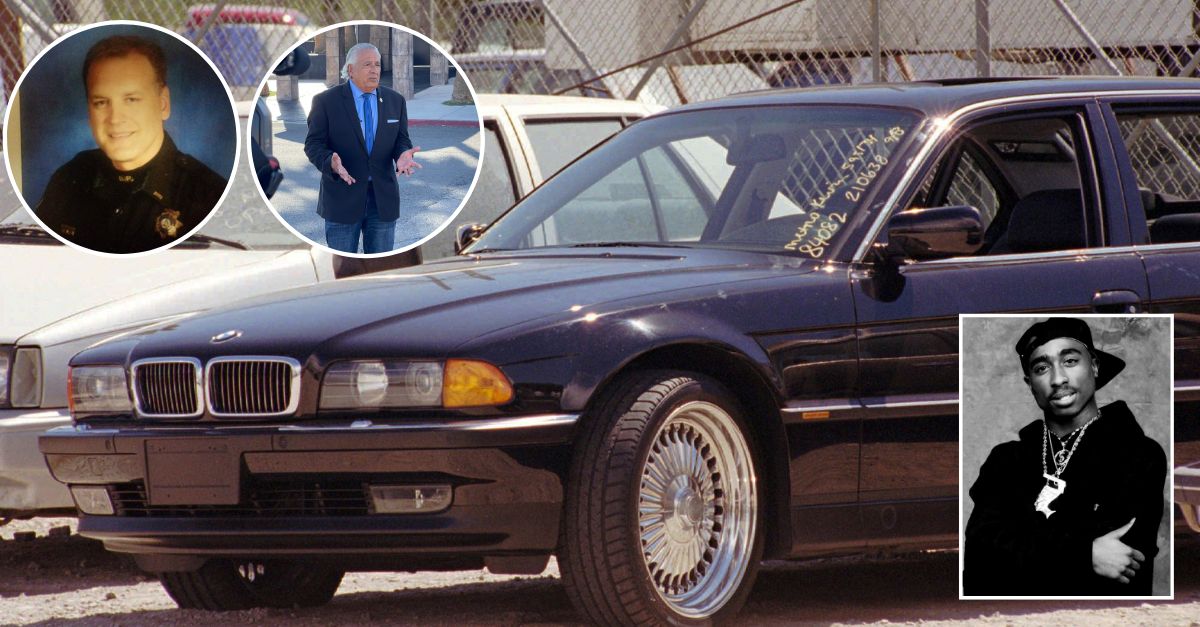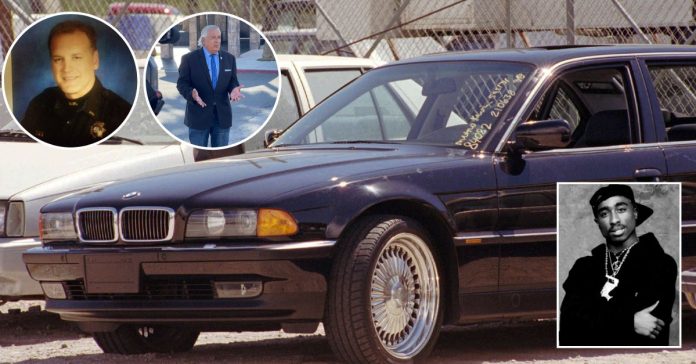
A black BMW, riddled with bullet holes, is seen in a Las Vegas police impound lot on Sept. 8, 1996. Rapper Tupac Shakur was shot while riding in the car driven by Death Row Records chairman Marion “Suge” Knight on Sept. 7, 1996, and died six days later. Knight was wounded but survived. (AP Photo/Lennox McLendon) Inset upper left: Police photo of retired Las Vegas police officer Chris Carroll (via LVMPD). Inset upper right: Retired Las Vegas homicide detective Phil Ramos speaks with Law&Crime Network (via Law&Crime) Inset lower right: File photo of Tupac Shakur (Pat Johnson/MediaPunch/IPX)
While the man allegedly behind the assassination of rap icon Tupac Shakur awaits a hearing in Las Vegas, Law&Crime accompanied two former police officers as they recounted the night the rapper died.
Retired Las Vegas Metropolitan police officers Chris Carroll and Phil Ramos were at the intersection of Harmon and Las Vegas Boulevard within minutes of Tupac Shakur and Death Row Records producer Marion “Suge” Knight being shot.
Investigators now accuse an alleged leader of the Compton South Side Crips, Duane “Keefe D” Davis, of orchestrating the drive-by shooting.
A grand jury indictment in Clark County District Court accuses Davis of murder, with sentencing enhancements for the use of a deadly weapon and alleged gang activity.
Authorities say Davis ordered his nephew, Orlando “Baby Lane” Anderson, to shoot Shakur as the white Cadillac they were in pulled up alongside the BMW Knight was driving. Shakur was shot multiple times and died a week later.
Anderson was killed in a shootout in 1998. He always denied any involvement in Shakur’s death.
Chris Carroll was a sergeant on bike patrol on Sept. 7, 1996. He remembers the night vividly, telling Law&Crime’s Angenette Levy that the city was abuzz.
“That night was a Mike Tyson fight,” Carroll said. “So it’s a very, very busy night on the Strip. And it always was, if Mike Tyson had a fight.”
Shakur and his crew attended the Tyson boxing match that night at the MGM Grand. After the fight, Shakur encountered Anderson in the casino and a fight erupted. The brawl eventually broke up, with Shakur and Knight getting into the BMW to head to Knight’s 662 Club.
Carroll says he was first notified there was trouble when he heard chatter on his police radio about a shooting.
“There were some officers that were in a parking structure over at Koval and Flamingo,” Carroll told Levy. “They had heard a bunch of shots ring out. So they got on the radio and said that, you know, that they got a bunch of gunfire. I could kind of hear it in their voice, that they were a little bit excited.”
Carroll says when he got to the scene, he approached the passenger side door of the BMW, where he found Shakur wounded and bleeding.
“So as I opened the door, he kind of slumps out of the door,” Carroll recalled. “He kind of slides out as I open the door.”
The former officer says he tried to ask Shakur who shot him and got an unexpected response.
“I just came down to the pavement with him. So we’re on the pavement, I’m on a knee, he’s laying kind of on his butt. I’m sitting him up a little bit, trying to talk to him,” Carroll said.”
“I was hoping to get a name, anything that I could, or a description. I was hoping for something,” Carroll continued. “He kind of looked at me and he got his breath together and he went ‘f— you.’ And he said it like with anger in his voice, like he didn’t want to deal with me, basically.”
As Shakur was rushed to a hospital, detectives were called to the scene, including retired Las Vegas Metro Police Detective Phil Ramos.
“Once everything had gotten somewhat sorted out and the realization of who the victim was came to light, it became very dynamic,” Ramos told Levy about the case that would soon become one of Las Vegas’s most high-profile homicide cases.
Ramos talked about the steps taken to save the rapper.
“The staff was doing a miraculous job keeping him alive as long as they did. They just really went above and beyond to save his life,” Ramos said. “But it was very apparent that night that he wasn’t going to survive those injuries.”
Ramos had hoped the main eyewitness, Suge Knight, would help catch the shooter. But that didn’t happen.
“He was in the car. The bullets were going by him. He saw his friend get shot up and he’s telling the cops, ‘I didn’t see anything.’ But we knew it was a bunch of crap. It was a gang-related shooting and those were typically very, very difficult to get any cooperation from anyone,” Ramos said. “And this was no different.”
Shakur’s mother, Afeni Shakur, made the difficult decision to take her son off life support six days after the shooting.
“His mom decided, ‘I don’t want him to suffer anymore. Let’s just leave it in God’s hands.’ And she made that decision to terminate life support,” Ramos said.
Even though Tupac Shakur’s family and friends, as well as officials, said the rapper was dead, conspiracy theories saying he was still alive were rampant.
“I just shook my head and thought, ‘I don’t know why people do this,”” Ramos said. “People just don’t want to accept the fact that someone they admire so highly is actually dead. You know, we’ve seen it with other celebrity deaths. Jimi Hendrix, Stevie Ray Vaughn, John Lennon. The people just don’t accept that. They come up with all these crazy ideas.”
“Because even Tupac’s mom said, ‘My son is dead. This isn’t some crazy conspiracy. He’s not on some island in the Caribbean. My son is dead. Respect that,’” Ramos noted. “But to this day, it still happens.”
“I saw his body,” Ramos said. “I can tell you he’s dead.”
Carroll says police knew who the shooter was.
“I think the investigators and most of us cops, we pretty much knew that Orlando Anderson was the shooter,” Carroll said. “And it turns out, he’s murdered himself a year and a half or so later, after the murder. So there’s really nobody at that time to arrest.”
Ramos recalled that it was frustrating dealing with the wall of silence around the case.
“This is Tupac Shakur,” Ramos said. “He’s loved by people all over the world. And if there was ever a case where, you know, the law of the streets should be forgotten, this was one of them. You don’t have to be labeled a snitch just because you help the cops with what you know and what you saw when someone of this stature is murdered. But they just wouldn’t do it.”
In his memoir, “Compton Street Legend,” Duane Davis admitted he was in the front passenger seat of the Cadillac and passed a gun to the backseat, where the shots allegedly came from. He implicated his nephew, Anderson, saying he was one of two people the back of the car.
In 2009, Davis found himself in trouble on drug charges and agreed to confess to his role in the killing of Shakur. That confession, known as a proffer, couldn’t actually be used to prosecute him — but that didn’t stop him from speaking publicly about the shooting.
During the nearly three-month grand jury investigation before Davis’ 2023 arrest, prosecutors showed jurors clips from interviews Davis granted to the “Art of Dialogue” YouTube channel.
In an interview from September 2021, Davis talks about waiting for Shakur and Knight to show up at a club after the Mike Tyson fight so that Anderson and Shakur could fight. When the two didn’t show, the men in the Cadillac left, but spotted Shakur riding in the BMW.
According to that interview, the expectation was that another man in the Cadillac, DeAndre Smith, was going to shoot Shakur. But Davis told the interviewer, “not everyone is a killer.” So Anderson reportedly took the gun from Smith and fired the fatal shots.
Davis is due back in court on Oct. 19 for an arraignment hearing.
Angenette Levy contributed to this report.
Have a tip we should know? [email protected]

